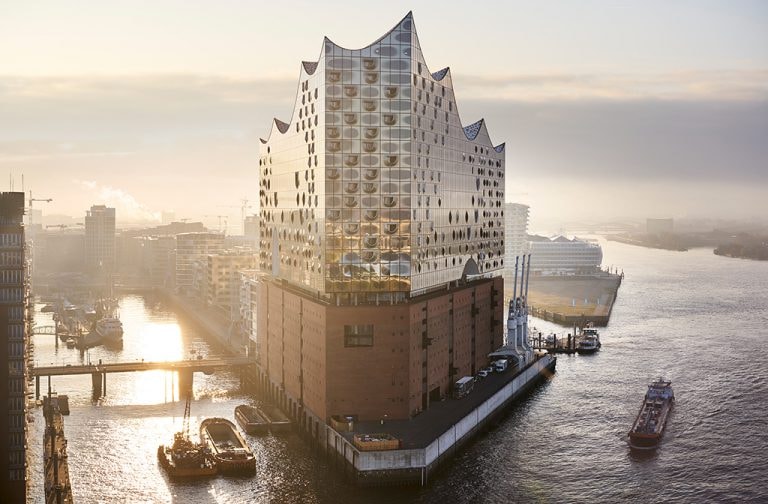The Elbphilarmonie of Hamburg, Germany

The Elbe Philharmonic Hall (German: Elbphilharmonie) is a concert hall in the HafenCity neighborhood of Hamburg, Germany, on the Grasbrook peninsula (of) the Elbe River. It is one of the largest and acoustically advanced concert halls in the world. As majestic and imposing So majestic and imposing as The Paris Opera, the Palais Garnier, is one of the most important monuments in Paris, in addition to one of the most visited opera and ballet theaters in the world and has been chosen as the setting and setting for numerous literary pieces, theatrical and movies.
It is popularly nicknamed Elphi. Elbphilharmonie officially opened with concerts of the NDR Elbphilharmonie Orchestra and a light show on January 11, 2017.
In the flow of the Elbe and surrounded on three sides by water, the new concert hall will become the center of attraction for all who live in Hamburg, as well as for visitors from all over the world.
The spectacular building houses three concert halls, a large music education area, a variety of places to eat and drink, a hotel and the public square, which offers visitors an unparalleled panoramic view of the entire city.
The artistic quality, variety and accessibility make up the musical program of Hamburg’s new cultural landmark.
The new vitreous construction resembles a raised candle, a water wave or a quartz crystal; It is located above an old warehouse building (Kaispeicher A, built in 1963) near the historic Speicherstadt and is designed by the architectural firm Herzog & de Meuron.
It is the tallest inhabited building in Hamburg, with a final height of 108 meters (354 feet).
Elbphilharmonie is a total work of art: it combines an innovative architecture with an exceptional location, outstanding acoustics and a visionary concert program.
Building:
The building is designed as a cultural and residential complex. The original 1966 brick facade of Kaispeicher A, formerly a warehouse, remained at the base of the building.
In addition to this, a superstructure that combines with the footprint rests on its own base, exhibiting a glassy exterior and a wavy roof line. Around a thousand glass windows are curved.
The building has 26 floors with the first eight floors inside the brick facade. It reaches its highest point with 108 meters on the western side. The footprint of the building measures 120,000 m2.
A curved escalator from the main entrance on the east side connects the ground floor with an observation platform, the Plaza, on the 8th floor, the top of the brick section.
The Plaza is accessible by the public. It offers a view of Hamburg and the Elbe. From the Plaza you can reach the lobby of the concert hall.
The design of the Herzog & de Meuron architects office provided the then existing structure of the 1966 Kaispeicher A brick before a glass-clad structure with a strikingly curved roof shape, which was also called a «glass shaft.» The objective was a characteristic feature of the building to form an unmistakable silhouette in Hamburg.
Concert halls:
The users of the concert halls are HamburgMusik gGmbH. Even before the opening ceremony, the so-called “Elbphilharmonie concerts” were organized, both in Laeiszhalle and elsewhere in Hamburg. Managing Director of Elbphilharmonie and Laeiszhalle since 2007 Christoph Lieben-Seutter.
There is a large concert hall with 2100 seats, a small hall with 550 seats and a third hall, the Kaistudio 1, with 170 seats. The lobby of the great room is designed with oak parquet.
Public space: The Plaza
Between the brick base and the glass structure, 37 meters away, there is a public space that serves as the access level for the lobby of the concert halls and the hotel.
The Plaza is accessed through an escalator approximately 80 meters long and 21 meters high (the so-called tube) and a second shorter escalator. Part of the Plaza is an outdoor tour around the entire building.
Urban marketing concept
The Elbphilharmonie Hamburg was already announced at an early stage by HafenCity Hamburg GmbH, which is responsible for the development and commercialization of HafenCity, together with the International Maritime Museum Hamburg and the Science Center previously planned as one of the central cultural centers, institutions of HafenCity.
In addition to its use as a concert hall, the Philharmonic Senate also expected the creation of a landmark for Hamburg and HafenCity, especially with regard to the international representation of the city.
The reason for creating a benchmark was resumed early for official advertising and image campaigns.



